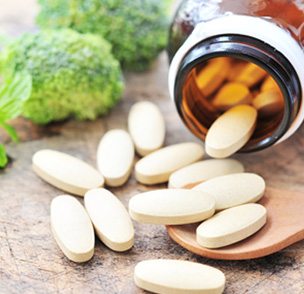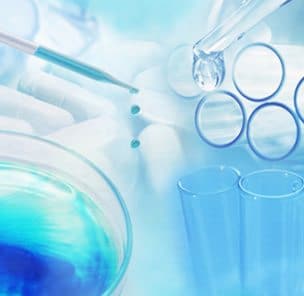What is Chronobiology?

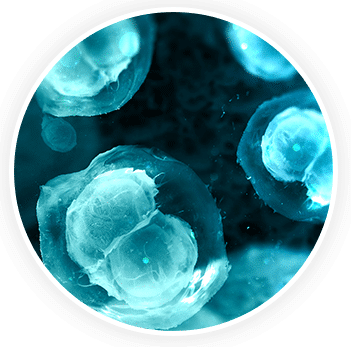
A New Understanding of Medicine
Chronobiology has had an outstanding influence on the development of modern food supplements. In different compositions for administration in the morning and evening, the mostly plant-based constituents of these products have been specifically adapted to the organs’ needs at the particular time of day during this difficult phase.
Governed by the laws of chronobiology, they support the body’s own hormonal processes in an innovative and natural way, finely tuned to the needs at the particular time of the day. This ensures that all phytonutrients are taken correctly, for example with Menochron® (female) and Androchron® (male), both obtainable without a prescription from the manufacturer Chronoceuticals®.
Glands, Hormones, and Our Inner Clocks

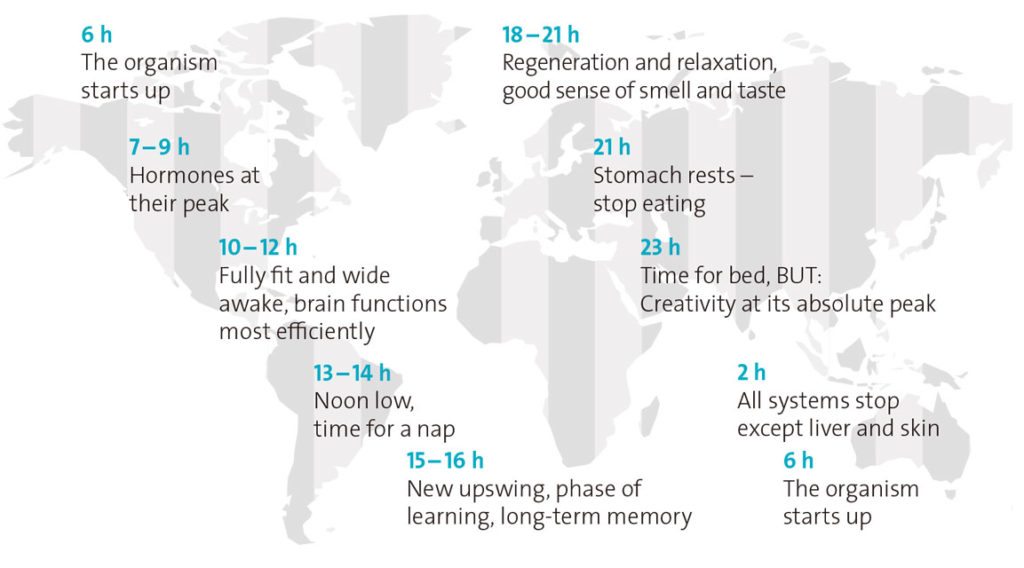
Controlled by Messenger Substances
Messenger substances control us day and night. Contrary to what has been assumed for a long time, it is not electrical impulses but chemical molecules that transmit the most important pieces of information in the human body. The name of these molecules? Hormones. Medical science already knows as many as 156 such active endogenous regulators and coordinators of the body’s metabolism. If necessary, they are activated in certain cells. They are transported to their place of action in the blood, in the lymphs and in intercellular fluid. They control the activity of the organs without directly participating in the metabolic processes. In order to prevent the organism from being inundated with them, they are deactivated after a relatively short time.
Following the Rhythm of the Inner Clock
A few interesting examples: Between 7 a.m. and 9 a.m. in the morning the messenger substances—not only the sexual ones—are at their peak. Between 3 and 4 p.m., a high phase of our long-term memory makes us most capable of learning. By around 11 p.m. the level of the sleeping hormone melatonin has increased tenfold and switches the organs to regeneration. This is an extremely important impulse which is lost in many elder people. During healthy sleep, the body’s temperature is reduced upon the command of the messenger substances. When we wake up the blood pressure rises.
A few decades ago, chronobiologists, the representatives of this new science, were still derided. Today, relevant formulas for providing the body with essential substances are available thanks to their findings. These formulas take into consideration the relationship between the metabolic processes and the time of the day.
Starting point: Glands
Most messenger substances are produced in the glands, primarily in the pituitary gland and the hypothalamus in the brain, in the thyroid gland and parathyroid gland, in the pancreas, the adrenal glands, the ovaries and the testicles. Other hormones are produced directly in the tissue at the place of their action. A complicated feedback system consisting of external and internal timers subjects the intensity of these information transmitters to a distinct 24-hour rhythm. This inner clock is an important control factor for the release of hormones. The more intelligently we bear in mind this chronobiological factor the greater the benefit for our bodies.
Orchestra of Hormones
Every emotion, every bout of energy, every growth command, every outbreak of anger, every repair order, every feeling of lust, every blush and, most of all, any sexual stirring, is the echo of the dosage of hormones.
In addition, the renewal of our bones, the blood pressure, the body’s water balance, the blood sugar level or the intensity of sleep during the night result from the release of certain hormones.
In this concert of 156 or more messenger substances, some players are of paramount importance. Individually or as a group, these are the sexual hormones estrogen, progesterone and testosterone, the growth hormone, a basic hormone called DHEA, the brain-performance-enhancing substance pregnenolone and melatonin.
Best Form: A Short-time Blessing
Unfortunately, our hormones are not at our disposal in the desired intensity for our entire lives. From the age of 30 on—upon fulfillment of the procreation mandate within the meaning of evolution—the production of important messenger substances is curbed more or less drastically.
Counteracting Hormone Deficiency, Anti-aging

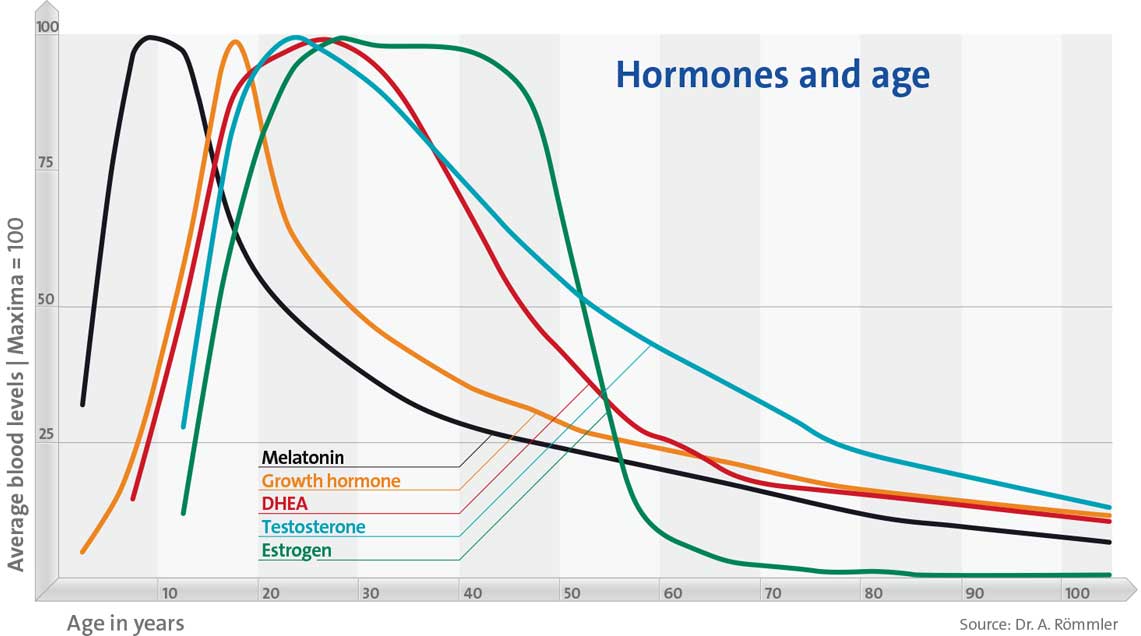
First “Upwards,” Now “Downwards”
The most important hormones that participate in building the human body are referred as “anabolic,” from the the Greek work for “upwards.” Apart from the sexual hormones, these are the growth hormone and DHEA. The levels of all these build-up hormones in the blood and in the tissue drop significantly over the years. With each individual declining messenger substance—regardless of whether the decline is slow or quick—the body loses an extremely important health factor. The effects are dramatic with a loss of vitality and increased proneness to illness.
Beware of the Disposition to Divorce!
A lack of the growth hormone affects not only the renewal of bones but also fatty tissue and muscles. HGH (for “human growth hormone,” the scientific name of this messenger substance) is also an important stabilizing factor for our psyche. A deficiency in this hormone can be one of the reasons for the high disposition to divorce that can be observed during female and male menopause.
Hormones Drop, Risks Rise
The messenger substances estrogen and progesterone are regarded as the female hormones. This categorization is somewhat misleading because these hormones also regulate the bone metabolism, vascular health and mood in the male body. However, their main role is that of the worker bees of the female sexual system. All physical and mental aspects imaginable are directly or indirectly geared towards conception. Smooth skin, strong hair, sensual smell, easy-going manner and encouraging looks are all the weapons in a woman’s arsenal of seduction that can probably be traced back to these hormones.
Other attractive elements of this are the typically female body forms resulting from the fat reserves the body has produced in order to make provision for a subsequent pregnancy. All too soon this shiny image begins to fade. First, the woman experiences a significant decline of the maternity or feel-good hormone progesterone that is produced in the ovaries. Then the production of the estrogens plummets. Few people are familiar with the fact that the lack of these substances also produces a huge gap outside the female sexual organs.
Basic Substance for 18 Complete Hormones
The endogenous substance with the designation dehydroepiandrosterone (DHEA) is produced in the adrenal cortex. It was only at the end of the 20th century that this substance was recognized as the “youth hormone.” 18 different messenger substances, including the so-called female messenger substances (estrogens) and male messenger substances (androgens), develop from DHEA in the female and male body, respectively.
Our organism reduces the production of DHEA to just one tenth until the age of 75.
The levels of all messenger substances related with that hormone take a plunge. The effects are profound. Still, there is only one instance of a hormonal deficit that the general public is really aware of: the female menopause.


